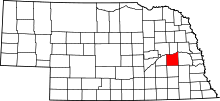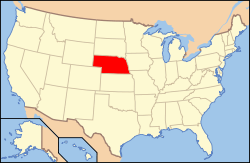Butler County, Nebraska
| Butler County, Nebraska | |
|---|---|
|
Butler County Courthouse in David City | |
 Location in the U.S. state of Nebraska | |
 Nebraska's location in the U.S. | |
| Founded | 1868 |
| Seat | David City |
| Largest city | David City |
| Area | |
| • Total | 591 sq mi (1,531 km2) |
| • Land | 585 sq mi (1,515 km2) |
| • Water | 5.9 sq mi (15 km2), 1.0% |
| Population | |
| • (2010) | 8,395 |
| • Density | 14/sq mi (5/km²) |
| Congressional district | 1st |
| Time zone | Central: UTC-6/-5 |
| Website |
www |
Butler County is a county in the U.S. state of Nebraska. As of the 2010 census, the population was 8,395.[1] Its county seat is David City.[2] The county was created in 1856[3] and organized in 1868.[4][5]
In the Nebraska license plate system, Butler County is represented by the prefix 25 (when the license plate system was established in 1922, it had the 25th-largest number of vehicles registered in the county).
In 2010, Nebraska's center of population was in Butler County, near the village of Rising City.[6]
Geography
According to the U.S. Census Bureau, the county has a total area of 591 square miles (1,530 km2), of which 585 square miles (1,520 km2) is land and 5.9 square miles (15 km2) (1.0%) is water.[7]
Major highways
Adjacent counties
- Saunders County, Nebraska (east)
- Seward County, Nebraska (south)
- Polk County, Nebraska (west)
- Platte County, Nebraska (northwest)
- Colfax County, Nebraska (north)
Demographics
| Historical population | |||
|---|---|---|---|
| Census | Pop. | %± | |
| 1860 | 27 | — | |
| 1870 | 1,290 | 4,677.8% | |
| 1880 | 9,194 | 612.7% | |
| 1890 | 15,454 | 68.1% | |
| 1900 | 15,703 | 1.6% | |
| 1910 | 15,403 | −1.9% | |
| 1920 | 14,606 | −5.2% | |
| 1930 | 14,410 | −1.3% | |
| 1940 | 13,106 | −9.0% | |
| 1950 | 11,432 | −12.8% | |
| 1960 | 10,312 | −9.8% | |
| 1970 | 9,461 | −8.3% | |
| 1980 | 9,330 | −1.4% | |
| 1990 | 8,601 | −7.8% | |
| 2000 | 8,767 | 1.9% | |
| 2010 | 8,395 | −4.2% | |
| Est. 2015 | 8,115 | [8] | −3.3% |
| U.S. Decennial Census[9] 1790-1960[10] 1900-1990[11] 1990-2000[12] 2010-2013[1] | |||
As of the census[13] of 2000, there were 8,767 people, 3,426 households, and 2,350 families residing in the county. The population density was 15 people per square mile (6/km²). There were 3,901 housing units at an average density of 7 per square mile (3/km²). The racial makeup of the county was 98.38% White, 0.10% Black or African American, 0.13% Native American, 0.13% Asian, 0.06% Pacific Islander, 0.81% from other races, and 0.40% from two or more races. 1.65% of the population were Hispanic or Latino of any race. 33.1% were of German and 32.0% Czech ancestry according to Census 2000.
There were 3,426 households out of which 33.00% had children under the age of 18 living with them, 59.90% were married couples living together, 5.70% had a female householder with no husband present, and 31.40% were non-families. 28.30% of all households were made up of individuals and 14.40% had someone living alone who was 65 years of age or older. The average household size was 2.53 and the average family size was 3.13.
In the county the population was spread out with 27.90% under the age of 18, 6.60% from 18 to 24, 25.30% from 25 to 44, 22.50% from 45 to 64, and 17.70% who were 65 years of age or older. The median age was 39 years. For every 100 females there were 104.10 males. For every 100 females age 18 and over, there were 101.20 males.
The median income for a household in the county was $36,331, and the median income for a family was $44,441. Males had a median income of $28,856 versus $20,979 for females. The per capita income for the county was $16,394. About 4.80% of families and 8.20% of the population were below the poverty line, including 9.80% of those under age 18 and 9.40% of those age 65 or over.
Communities
City
- David City (county seat)
Villages
Unincorporated communities
Ghost towns
Townships
See also
References
- 1 2 "State & County QuickFacts". United States Census Bureau. Retrieved September 17, 2013.
- ↑ "Find a County". National Association of Counties. Archived from the original on 2011-05-31. Retrieved 2011-06-07.
- ↑ Fitzpatrick, Lilian L. (1960). Nebraska Place-Names. University of Nebraska Press. p. 28. Retrieved December 13, 2014.
- ↑ Andreas, A. T. (1882). "Andreas' History of the State of Nebraska". The Kansas Collection. Retrieved December 13, 2014.
- ↑ "Butler County". Nebraska Association of County Officials. Retrieved December 13, 2014.
- ↑ "Centers of Population by State: 2010". United States Census Bureau. Archived from the original on January 3, 2014. Retrieved April 1, 2014.
- ↑ "2010 Census Gazetteer Files". United States Census Bureau. August 22, 2012. Retrieved December 6, 2014.
- ↑ "County Totals Dataset: Population, Population Change and Estimated Components of Population Change: April 1, 2010 to July 1, 2015". Retrieved July 2, 2016.
- ↑ "U.S. Decennial Census". United States Census Bureau. Archived from the original on May 11, 2015. Retrieved December 6, 2014.
- ↑ "Historical Census Browser". University of Virginia Library. Retrieved December 6, 2014.
- ↑ "Population of Counties by Decennial Census: 1900 to 1990". United States Census Bureau. Retrieved December 6, 2014.
- ↑ "Census 2000 PHC-T-4. Ranking Tables for Counties: 1990 and 2000" (PDF). United States Census Bureau. Retrieved December 6, 2014.
- ↑ "American FactFinder". United States Census Bureau. Archived from the original on 2013-09-11. Retrieved 2008-01-31.
 |
Platte County | Colfax County |  | |
| Polk County | |
Saunders County | ||
| ||||
| | ||||
| Seward County |
Coordinates: 41°13′N 97°08′W / 41.22°N 97.13°W